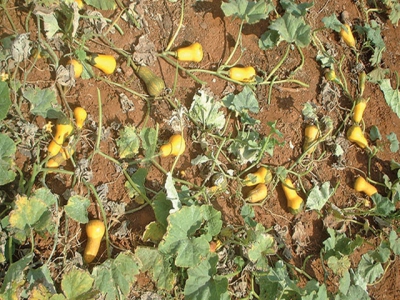Producing butternuts: Spacing, yield, diseases

The essentials of growing butternuts are similar to those of other cucurbits. Spacing may vary, however, depending on the cultivar. Some butternuts are compact growers, while others produce long runners.
Smaller fruit varieties produce greater numbers of fruit, but not necessary more tonnage. Photo: Bill Kerr
Bearing habits differ too. Some cultivars produce an even spread of fruit on the runners, while others set some fruit closer to the crown and continue growing before bearing more fruit
Only a relatively small percentage of female flowers will produce fruit to maturity.
The quantity of fruit is determined by the leaf area.
There are also differences between varieties in the number of female flowers that bear. But there should always be enough to produce a full yield.
The exception to this is baby butternuts, where a variety that produces a higher percentage of flowers will be more productive.
Since these are harvested at a very early stage, the plant will continue trying to get each female flower to produce a fruit and not abort them.
Spacing
Varieties with shorter runners can have rows closer together – about 1,5m apart. The optimal spacing for those that produce normal runners will vary according to cultivar.
For example, a variety that produces three or so fruit on a runner relatively close to the crown will continue growing for some length without allowing more fruit to develop until the leaf area is again sufficient for further fruit.
In this case, you should plant them closer if you want to harvest only the first flush. The second flush will mature much later and this may not suit you.
Yield
Pumpkins and gems tend to produce enough male flowers before the first female flowers open; the opposite is usually true of butternuts.
This is nothing to worry about. Production will not be lost because, as mentioned, the leaf area determines the volume of fruit set.
Smaller fruit varieties will produce more fruit than larger fruit varieties, but the actual tonnage will be similar.
Notwithstanding this, some varieties tend to produce relatively high yields for their leaf area.
Gummy stem blight and other diseases
Butternuts are significantly more disease-resistant than other cucurbits. And if they become infected, the symptoms are less severe.
Varieties with resistance to viruses and powdery mildew are available. Note, however, that for a hybrid to have resistance to the latter, both parents must be resistant.
One of the most problematic diseases for butternuts is gummy stem blight. Apart from affecting the general health of the plant, it causes dark irregular lesions on the fruit, making it unmarketable.
Gummy stem blight also prevents the crop from being stored. Commonly introduced by seed, the disease is usually noticed only when the fruit is harvested.
Store it for higher price
In warm areas, butternut can be grown through winter to be harvested in spring. But this will result in smaller fruit with a stumpy shape that will fetch lower prices.
Yield will also be lower. If you farm in a relatively warm area, rather plant the butternut sooner, and harvest the crop early in winter – it will be full size and the right shape.
But don’t sell it immediately.
Store it until summer (butternut stores very successfully) and sell it when the undersized fruit is being marketed.
You will obtain a higher price and get a premium due to the flesh colour improving in storage. When storing the fruit, place it on straw in a protected environment and inspect it frequently for any decaying fruit.
Also make sure that rodents are kept under control.
Related news
 Common watermelon fungal diseases
Common watermelon fungal diseases Watermelons are generally grown in fairly dry climates as this reduces the risk of diseases considerably.
 The strange history of the butternut
The strange history of the butternut Butternut belongs to the species Cucurbita moschata. Our regular pumpkins are C. maxima; gems and marrows are C. pepo.
 Getting watermelons ready for the market
Getting watermelons ready for the market To obtain high prices on the market, a watermelon grower has to produce fruit that looks good as well as tastes delicious.